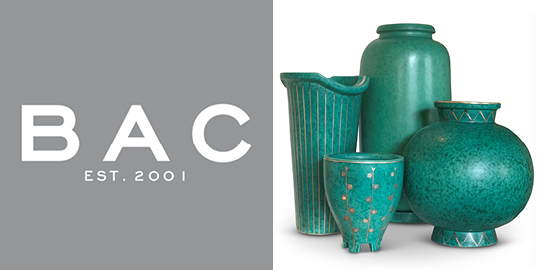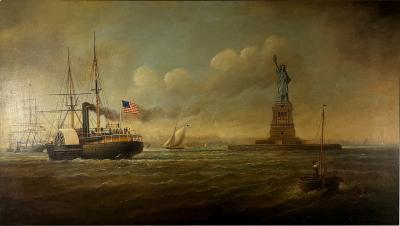Antonio Jacobsen
American, 1850 - 1921
Born in Copenhagen, Denmark in 1850 to a family of violin makers, Jacobsen emigrated to the United States in 1871. By 1880, he was living in West Hoboken, New Jersey, on the Palisades above the "City of Ships". It was here that he established himself as a successful ship portraitist. Jacobsen is recognized as the American artist who most successfully recorded the important transitional era of sailing vessels as they evolved from sail to steam. This in large part was due to the timely placement of his studio at the mouth of the New York Harbor. Paintings by Antonio Jacobsen display a meticulous and traditional nature underlined by strict attention to detail. Absolute accuracy in rigging, wind direction and specific vessel details contribute to Jacobsen's paintings' reputation as the best of their genre. Any marine collection of note features the work of this pivotal artist.
Antonio Jacobsen Paintings
Antonio Jacobsen Paintings
(1850-1921) Antonio Jacobsen is one of America's foremost marine painters. He was born in Copenhagen, Denmark to a family of violin makers and was himself an accomplished string player. To avoid being drafted into the Franco-Prussian War he emigrated to New York City in 1871. He sketched ships in the harbor area of Battery Park, where his work was noticed by owners of the Marvin Safe Company, who hired him to decorate safes. Later he was commissioned by the Old Dominion Line, the Fall River Line, and the White Star Line to paint their fleets; he also received commissions from the Clyde Line, Black Ball Line, Mallory Line, Anchor Line, and the Red Star Line, as well as independent ship captains and owners. Jacobsen remained in New York City until 1880 when he moved to Hoboken, New Jersey, where his home was a gathering place for marine artists including James Bard, Fred Cozzens, Fred Pansing, James Buttersworth, Worden Wood, Albert Bishop, and Ward Stanton. Jacobsen's painting style is often characterized by a
"flat"
or primitive or folk quality, rendered with great skill, a complete understanding of ships, and accuracy of detail. Two of his children, Helen and Carl, who became a painter in his own right, assisted with the painting of skies and water on some of the later canvases. Though Jacobsen made a successful living painting for steamer lines, he suffered a decline in finances toward the end of his life. However, even when lithographs became a popular form of disseminating art, he resisted attempts to capitalize on his work by having it reproduced. It is estimated that during his lifetime Jacobsen executed approximately 6,000 paintings. He frequently painted multiple versions of a vessel, the painting varying in size or ground. Jacobsen's paintings are an invaluable visual and artistic record of international ships during the great transition from the age of sail to the age of steam.
Biography courtesy of Roger King Gallery of Fine Art, www.antiquesandfineart.com/rking
Biography courtesy of Roger King Gallery of Fine Art, www.antiquesandfineart.com/rking
Antonio Jacobsen was a marine painter who studied at the Royal Academy of Copenhagen and is represent in every large marine museum in the U.S. and Europe. Jacobsen came to New York City in 1871 and made money by decorating the doors of bank safes. He began painting portraits of vessels in the "Old Dominion Steamship Line". Jacobsen painted about 6,000 steamships in the NYC harbor between 1876-1919. He truly was the most prolific marine painter ever. Many of Jacobsen's patrons were ship masters or boat owners in search of an accurately detailed record of their vessel. Jacobsen would make detailed sketches in pencil which he documented in catalogued notebooks before beginning his painting. Jacobsen died in 1921.
Biography courtesy of The Caldwell Gallery, www.antiquesandfineart.com/caldwell
Biography courtesy of The Caldwell Gallery, www.antiquesandfineart.com/caldwell
Antonio Nicolo Gasparo Jacobsen was born in Copenhagen, Denmark on November 2, 1850, the son of a famous Danish violinmaker. Jacobsen came to New York in 1873 and with a letter of introduction, was hired as a violinist for the New York Symphony Orchestra. However, this life did not appeal to him, and he decided to look for other work. As with most Danes, the lure of the sea and ships was part of his blood. He would spend his afternoons off sketching ships down at Battery Park, where an employee of the Marvin Safe Company noticed his drawings, and offered him a job decorating safes. It was while he was doing work for the Marvin Safe Company that Capt. Adolf Ludwig King, a Swedish captain for the Old Dominion Line noticed his work, and gave him his first commissions for ship portraits. This was to start Antonio Jacobsen on his lifes work as a ship portrait painter, a vocation he achieved with remarkable success.
In 1878 he married Mary Melanie Schmidt at the church of the Strangers in New York City. They lived in New York until 1880 when they purchased a large Victorian home in West Hoboken (now Union City) where Jacobsen set up his studio. This house originally had the address of 705 Palisades Avenue, and then in 1896 the numbers of the street changed, and the house was then numbered 31 Palisades Avenue. The artists home was a Mecca for seafarers and artists, including Fred Pansing, James E. Buttersworth, F. Bishop and Frederick Cozzens. On Sundays, Jacobsen would arrange concerts at his house, and he and his friends would play chamber music. Many tales exist regarding the artists personality, eclectic interests, and artistic methods - including his improvidence, multi-linguistic and musical talents, voracious book reading and collecting, and the utilization late in his career of his two sons painting backgrounds in his work. During all but his last few years, Jacobson enjoyed a comfortable lifestyle that reflected the financial success of his lifes work.
Toward the end of Antonio Jacobsens career his clientele shifted from the steamship companies to the art dealers selling these paintings for a mere $10 apiece. Jacobsen suffered a number of tragedies towards the end of his life. In 1909 his wife, Mary died; in 1917 a fire destroyed part of his house; in 1918 his two sons were called up for military service in World War I; and as his life changed he became depressed and suffered a number of minor strokes. The last stroke left him in a coma for five days, and he died on February 2, 1921.
Jacobsen deserves the dual title of marine historian and marine artist. His clients, mostly ships officers, crewmen, and owners demanded accuracy - and accuracy is what they received. He chronicled the transition from sail to steam and the full commercial magnetism of the port of New York. Jacobsen also painted a number of yacht portraits and yachting scenes that were commissioned by some of the most prominent families in the New York area. He worked from daylight to dusk, and often had several painting going at one time in order to meet promised deadlines. He was a prolific artist with over 2400 known works. Works by Jacobsen can be seen in most major collections of marine art. Two of the most extensive public collections are The Mariners Museum; Newport News, VA and the Peabody Museum in Salem, MA From Sail To Steam, The Story Of Antonio Jacobsen, Marine Artist by Anita Jacobsen, 1972
Biography courtesy of Roughton Galleries, www.antiquesandfineart.com/roughton
In 1878 he married Mary Melanie Schmidt at the church of the Strangers in New York City. They lived in New York until 1880 when they purchased a large Victorian home in West Hoboken (now Union City) where Jacobsen set up his studio. This house originally had the address of 705 Palisades Avenue, and then in 1896 the numbers of the street changed, and the house was then numbered 31 Palisades Avenue. The artists home was a Mecca for seafarers and artists, including Fred Pansing, James E. Buttersworth, F. Bishop and Frederick Cozzens. On Sundays, Jacobsen would arrange concerts at his house, and he and his friends would play chamber music. Many tales exist regarding the artists personality, eclectic interests, and artistic methods - including his improvidence, multi-linguistic and musical talents, voracious book reading and collecting, and the utilization late in his career of his two sons painting backgrounds in his work. During all but his last few years, Jacobson enjoyed a comfortable lifestyle that reflected the financial success of his lifes work.
Toward the end of Antonio Jacobsens career his clientele shifted from the steamship companies to the art dealers selling these paintings for a mere $10 apiece. Jacobsen suffered a number of tragedies towards the end of his life. In 1909 his wife, Mary died; in 1917 a fire destroyed part of his house; in 1918 his two sons were called up for military service in World War I; and as his life changed he became depressed and suffered a number of minor strokes. The last stroke left him in a coma for five days, and he died on February 2, 1921.
Jacobsen deserves the dual title of marine historian and marine artist. His clients, mostly ships officers, crewmen, and owners demanded accuracy - and accuracy is what they received. He chronicled the transition from sail to steam and the full commercial magnetism of the port of New York. Jacobsen also painted a number of yacht portraits and yachting scenes that were commissioned by some of the most prominent families in the New York area. He worked from daylight to dusk, and often had several painting going at one time in order to meet promised deadlines. He was a prolific artist with over 2400 known works. Works by Jacobsen can be seen in most major collections of marine art. Two of the most extensive public collections are The Mariners Museum; Newport News, VA and the Peabody Museum in Salem, MA From Sail To Steam, The Story Of Antonio Jacobsen, Marine Artist by Anita Jacobsen, 1972
Biography courtesy of Roughton Galleries, www.antiquesandfineart.com/roughton
Antonio Jacobsen
MAGNIFICENT DETAILED' LIBERTY' PAINTING OF NYC HARBOR BY ANTONIO JACOBSEN
H 24 in W 42 in D 1 in
$ 38,000
